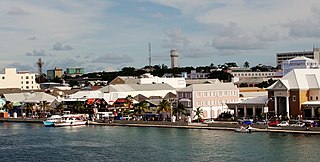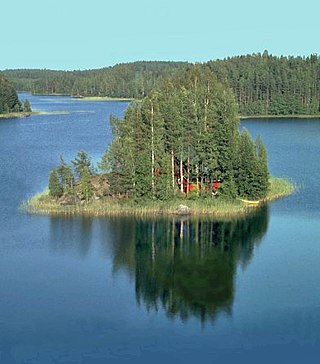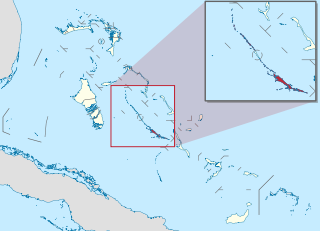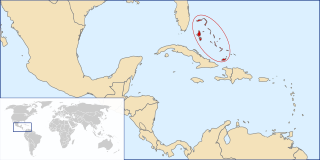
The Bahamas, officially the Commonwealth of The Bahamas, is an island country within the Lucayan Archipelago of the Atlantic Ocean. It contains 97% of the Lucayan Archipelago's land area and 88% of its population. The archipelagic country consists of more than 3,000 islands, cays, and islets in the Atlantic Ocean, and is located north of Cuba and northwest of the island of Hispaniola and the Turks and Caicos Islands, southeast of the U.S. state of Florida and east of the Florida Keys. The capital is Nassau on the island of New Providence. The Royal Bahamas Defence Force describes the Bahamas' territory as encompassing 470,000 km2 (180,000 sq mi) of ocean space.

Nassau is the capital and largest city of the Bahamas. It is located on the island of New Providence, which had a population of 246,329 in 2010, or just over 70% of the entire population of the Bahamas. As of April 2023, the preliminary results of the 2022 census of the Bahamas reported a population of 296,522 for New Providence, 74.26% of the country's population. Nassau is commonly defined as a primate city, dwarfing all other towns in the country. It is the centre of commerce, education, law, administration, and media of the country.
This article talks about transportation in the Bahamas, a North American archipelagic state in the Atlantic Ocean.

The Abaco Islands lie in the north of The Bahamas, about 193 miles east of Miami, Florida, US. The main islands are Great Abaco and Little Abaco, which is just west of Great Abaco's northern tip. There are several smaller barrier cays, of which the northernmost are Walker's Cay and its sister island Grand Cay. To the south, the next inhabited islands are Spanish Cay and Green Turtle Cay, with its settlement of New Plymouth, Great Guana Cay, private Scotland Cay, Man-O-War Cay and Elbow Cay, with its settlement of Hope Town. Southernmost are Tilloo Cay and Lubbers Quarters. Also off Abaco's western shore is Gorda Cay, a Disney-owned island and cruise ship stop renamed Castaway Cay. Also in the vicinity is Moore's Island. On the Big Island of Abaco is Marsh Harbour, the Abacos' commercial hub and The Bahamas' third-largest city, plus the resort area of Treasure Cay. Both have airports. Mainland settlements include Coopers Town and Fox Town in the north and Cherokee and Sandy Point in the south. Administratively, the Abaco Islands constitute seven of the 31 Local Government Districts of The Bahamas: Grand Cay, North Abaco, Green Turtle Cay, Central Abaco, South Abaco, Moore's Island and Hope Town.

A private island is a disconnected body of land wholly owned by a private citizen or corporation. Although this exclusivity gives the owner substantial control over the property, private islands remain under the jurisdiction of national and sometimes local governments. Their size can vary widely, from that of a typical suburban yard to several hundred square kilometers.

Exuma is a district of The Bahamas, consisting of over 365 islands and cays.

George Town is a town located on the island of Great Exuma in the Exuma district of the Bahamas. It had a population of 2,488 based on 2012 estimates.
Sandals Resorts is a Jamaican operator of all-inclusive couples resorts in the Caribbean. The company is a part of Sandals Resorts International (SRI), which also operates Beaches Resorts, Fowl Cay Resort, and several private villas. Founded by Jamaican-born entrepreneur Gordon "Butch" Stewart in 1981, SRI is based in Montego Bay, Jamaica and is responsible for development, service standards, training, and day-to-day operations of the resorts.

Cyclura cychlura inornata, the Allen Cays rock iguana or Allen Cays iguana, is a subspecies of the northern Bahamian rock iguana that is found on Allen's Cay and adjacent islands in the Bahamas. Its status in the IUCN Red List is critically endangered. The population has been growing over the last century. Although it was considered extinct in 1916, there are as of 2018 at least 482 mature adult animals counted on two islands, Leaf Cay and U Cay, and a few hundred on at least five other nearby islands where they have recently spread to by unknown means, as well as many juveniles.

Cyclura cychlura figginsi, known by the common name of guana and sometimes called the Exuma Island iguana in the international literature, is a subspecies of the northern rock iguana, C. cychlura, that is found on the Exuma island chain in the Bahamas with an estimated wild population of 1,300 animals in 2004, it has been listed on the IUCN Red List as critically endangered.

The following outline is provided as an overview of and topical guide to The Bahamas:
The Bahamas National Trust is a non-profit organisation in the Bahamas that manages the country's 32 national parks. Its headquarters is located in New Providence in the Bay Street Business Centre, East Bay Street. Its office was formally located at The Retreat Gardens on Village Road. The Bahamas National Trust was created by an Act of Parliament in 1959, through the efforts of two groups of conservationists.

The following is an alphabetical list of topics related to the Commonwealth of The Bahamas.

The Exuma Cays Land and Sea Park is a protected area in the Exuma Cays of the Bahamas. The protected area extends from Shroud Cay in the north to Bell Cay in the south. The vegetation consists of mangrove communities, with the east sides being clad in low scrub and the western sides with taller scrub. There are many epiphytic orchids and bromeliads.

Staniel Cay Airport is an airport serving Staniel Cay, one of the Exuma Islands in The Bahamas.

Long Island is an island in The Bahamas that is split by the Tropic of Cancer. It is one of the Districts of the Bahamas and is known as the most scenic island in the Bahamas. Its capital is Clarence Town. The population of Long Island is 3,094 inhabitants.
Staniel Cay is an island located in The Exuma Cays, a district of The Bahamas.
Bell Island is a private island inside the Exuma Cays Land and Sea Park, in the island archipelago of the Exumas, which is in turn part of the Lucayan Archipelago. As of 2021, it was a territory of The Bahamas. The island has a surface of 349 acres. Sometimes the island is called Big Bell Island, and it is not to be confused with nearby Little Bell, which is also known as Cambridge Cay.
Torch Cay is a privately owned island located east of Little Exuma at the southernmost point of the Exuma island chain. This member's only private island is 707 acres in size, making it the largest private island in the Bahamas. Torch Cay derives its name from the white torch tree and found amongst the land’s rare and lush vegetation. The island is home to Torch Cay Airport, the only known airport on a private island worldwide where you can land and clear customs with an ultra-long-range or heavy private jet.













